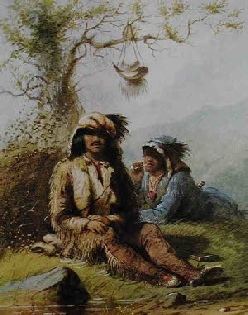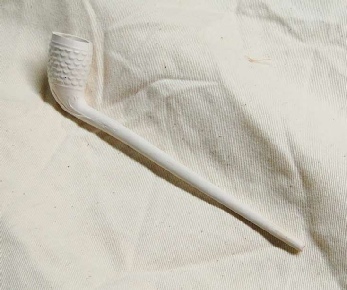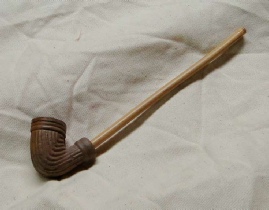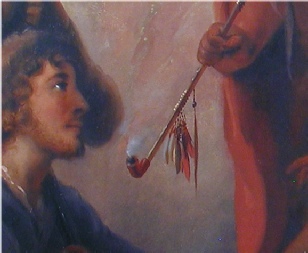Subject Guide

Mountain West
Malachite’s Big Hole
Clay Tobacco Pipes:
Tobacco seems to have been ubiquitous to the lifestyle of the men who pursued the fur trade and the pipe was the nicotine delivery method of choice, for voyageurs as well as the mountain men. The image below is by Alfred Jacob Miller in 1837 showing Moses “Black” Harris and a companion at leisure. Harris companion is clearly seen smoking a white clay pipe. Large numbers of clay pipes were documented going to the mountains on trade inventories. The 1835 trade inventory of items shipped to the Upper Missouri Outfit at Fort Union includes 20 gross (2,880) of “hunter’s clay pipes.”
 The use of clay pipes began in England shortly after the introduction of tobacco
in the mid 1500’s. The concept of the clay tobacco pipe was probably adapted from
the Native American Indians. The English clergyman, William Harrison (1534 – 1593)
stated in his Great Chronologie, “In these daies the taking-in of the Indian herbe
called ‘Tobaco’ by an instrument formed like a little ladell, whereby it passeth
from the mouth into the hed and stomach, is gretlie taken up and used in England,
against Rewmes and some other diseases engenderd in the longes and inward partes
and not without effect.”
The use of clay pipes began in England shortly after the introduction of tobacco
in the mid 1500’s. The concept of the clay tobacco pipe was probably adapted from
the Native American Indians. The English clergyman, William Harrison (1534 – 1593)
stated in his Great Chronologie, “In these daies the taking-in of the Indian herbe
called ‘Tobaco’ by an instrument formed like a little ladell, whereby it passeth
from the mouth into the hed and stomach, is gretlie taken up and used in England,
against Rewmes and some other diseases engenderd in the longes and inward partes
and not without effect.”
(Another method of nicotine deliver used by the Indians at the time of early European contact was tobacco rectal suppositories. This delivery method did not find favor with Europeans.)
Although the general form of the tobacco pipe is mostly unchanged from those earliest pipes, consisting of a bowl to hold and burn the tobacco, and a stem to deliver the smoke to the mouth, the size, styles, and decorative features of the pipe regularly changed through time. The earliest pipes in the mid to late 1500’s had very small bowls. The inside diameter of the bowl of many of these early pipes was as small as ¼ inch (Ayto, page 4). Tobacco in Europe at this time was a relatively expensive luxury item as well as a relatively rare commodity. A small bowl allowed a person to extend his supply of tobacco. As tobacco became more readily available and less costly, the capacity of pipes increased.
The fashion for long stems began in the mid-1700’s when stems reached lengths of 18-24 inches. By 1850 stems as long as 36 inches were available (Elliot). These long stemmed pipes were intended to be supported by the stem or bowl and smoked in moments of leisure. Most laborers however preferred simple pipes with stems of 6 inches or less, which could be gripped in the teeth while continuing with their work.
From England, the manufacture of clay pipes spread to the Low Countries, Germany, and to a lesser extent Denmark.
In France, the preferred method of nicotine delivery was by snuff, and so clay pipe manufacture didn’t start in that country until well into the 1700’s. The earliest pipe makers in Holland were Englishman. King James I of England discouraged the use of tobacco (A Counterblaste to Tobacco written in 1604) and restricted the manufacture of tobacco pipes to those pipemakers located in London. For this reason, numbers of English pipemakers resettled in Holland. Dutch pipes have a style unique from the English pipes. Early German pipes resemble in style the Dutch pipes until about the middle of the 1700’s. At this time the Germanic porcelain style pipes were developed which were immensely popular with German and Austrian smokers. These pipes consisted of a glazed ceramic bowl, fitted with an ornate wooden stem and a horn mouthpiece. Elaborate scenes were often painted on the ceramic bowl.
Around 1700 improvements in pipe manufacturing skills resulted in a smoother finish on the pipe surface, thinner bowl walls, and more slender stems. This is thought to have been a result of both improvements in firing techniques and introduction of the gin-press (Ayto, page 6). Pipes with elaborate patterns and figures also became widely available at this time. The image below is of a gin-pressed clay pipe reproduction.
 European white clay pipes were made using “china clay” a clay composed chiefly of
the mineral kaolinite. The clay is mined from quarries, but because it is seldom
pure enough to use directly, further processing is necessary to remove grit, rock
fragments and other bits of foreign matter. The lumps of raw clay would have been
milled to smaller pieces and washed in water, separating the clays from the other
undesirable materials. After this was done, excess water was drained off, and the
clays allowed to dry to a certain consistency. After the clay had dried, but was
still pliable, it was beaten with an iron bar to remove any remaining air in the
clay. This resulted in a very dense clay.
European white clay pipes were made using “china clay” a clay composed chiefly of
the mineral kaolinite. The clay is mined from quarries, but because it is seldom
pure enough to use directly, further processing is necessary to remove grit, rock
fragments and other bits of foreign matter. The lumps of raw clay would have been
milled to smaller pieces and washed in water, separating the clays from the other
undesirable materials. After this was done, excess water was drained off, and the
clays allowed to dry to a certain consistency. After the clay had dried, but was
still pliable, it was beaten with an iron bar to remove any remaining air in the
clay. This resulted in a very dense clay.
After being beaten with the iron bar, the clay was kneaded by hand to a uniform consistency. The clay was now divided into small, uniform masses with sufficient material to form a complete pipe. These masses were rolled out into a narrow cylinder with a larger blob on one end, roughly approximating the shape of a pipe. These approximations were called rolls, and when finished were placed 12 on a board, called a “dozening” board. The work of roughing out the “rolls” was generally done by women and children who were known as “rollers.”
After a short drying period, the pipe molder would begin to work with the rolls. The molder would start by inserting a narrow iron or brass rod up the center of the stem portion of the roll. Next the roll and rod would be placed in one half of the pipe mold. The other half of the mold was then positioned and the mold placed in a hand vice or gin press and squeezed until all of the excess clay had been forced out of the mold. The bowl was formed by forcing an appropriately shaped stopper by hand or by a lever on the gin press down into the bowl portion of the roll. After the stopper was removed, the rod was advanced into the void space in what is now the bowl. The mold is now separated and the pipe removed. Starting about 1750 cast iron was used for the molds (Elliot).
Excess clay from the mold joints and top of the bowl are trimmed, before the rod is withdrawn from the stem. A wire was usually placed in the bore of the stem to prevent the still soft clay of the stem from closing in on itself during the drying process. If the stem is to be curved, the wire was withdrawn before the clay was fully dried and then the stem was gently bent to shape. Once fully dry, any remaining rough edges are trimmed and burnished.
Unfired pipes could be made up quite quickly and a boy (roller) and a pipemaker could easily make up as many as five gross (720) pipes in a single day (Rex Wilson, 1971).
Once dry, the pipes were placed on a special rack called a “saggar” for firing. A single sagger might hold dozens or hundreds of pipes, and the saggars could be stacked in the kiln. It was important that the pipes be fully dried before firing in a kiln because on heating any moisture remaining in the clay would convert to steam and cause cracking or spalling of the clay. Firing and cooling of the pipes in a kiln was generally a three day process. Even with fully dried clay, temperatures were raised very slowly to drive off any residual moisture before raising the temperature to about 1650 degrees F. Kiln thermometers were not available to the pipemakers of this time, and so it was up to the experience and skill of the pipemaker to determine when the proper firing temperature had been reached. After firing the last step in finishing the pipe was application of a wax, gum or soap to the end of the stem to prevent the smokers lips from sticking to the clay. Finished pipes were packed in wooden boxes using sawdust, or wood shavings as packing material.
According to Knight (1875 page 2583-2584) common clay pipes ranged in price from 50¢ to $1.20 per gross (144). Thus these common clay pipes were treated almost as disposable items. It was not an unusual practice for taverns and inns to provide a pipe with tobacco along with the meal and drink. At the end of the evening the pipes would be gathered up and placed in the fire, where any residual ash and tar would be burned off, leaving the pipe in a “like new” condition.
English, German and Dutch pipes were all exported to North America, where some of
these pipes found use as trade goods in the fur trade. Starting in about 1740 a
different kind of clay pipe was produced domestically in the United States. Pipemakers
in the Pamplin area of Virginia produced a pipe with a relatively large bowl with
a short stem, into which a longer reed stem would be inserted. Below is an image
of a Pamplin clay pipe with a reed stem. 
Clays in the Pamplin area were high quality for pipemaking, but were a deep red color,
producing brown to red colored clay pipes. Pipemaking continued at Pamplin until
1951 (French). Below is a portion of “The Trappers Bride” by Alfred Jacob Miller,
1837, showing what appears to be a Pamplin clay pipe.
Today there are no commercial sources of gin-pressed clay pipes. Slip-poured clay pipes in the old patterns are available to reenactors. Gin-pressed clay pipes can be easily discerned from slip-poured pipes which start with clays with a far higher water content. After firing the gin-pressed clay pipe has a surface which has a polished feel to it, whereas the slip-poured pipe has a porous texture and feel.
Ayto, Eric G., Clay Tobacco Pipes, 3rd Edition, published by Shire Publications Ltd., 2002, Buckinghamshire UK. ISBN 0 7478 0248 3
Elliot, S. British Clay Tobacco Pipes from http://www.mosi.org.uk/media/614097/british clay tobacco pipes (large print).rtf
French, Mary. 2006. Pamplin Clay Tobacco Pipes Minigallery - Museum of Anthropology - University of Missouri-Columbia http://anthromuseum.missouri.edu/minigalleries/pamplinpipes/pamplinpipes.shtml
Knight, Edward Henry; Knight’s American Mechanical Dictionary: A Description of Tools, Instruments, Machines Processes, and Engineering; History of Inventions; Volume III, published by Houghton, Mifflin and Company, Boston, 1875.
Wilson, Rex L., Clay tobacco pipes from Fort Laramie National Historic Site and related locations, 1971, published by Division of Archeology and Anthropology, Office of Archeology and Historic Preservation, Washington.
Back to the Top
Back to Foods and Consumables